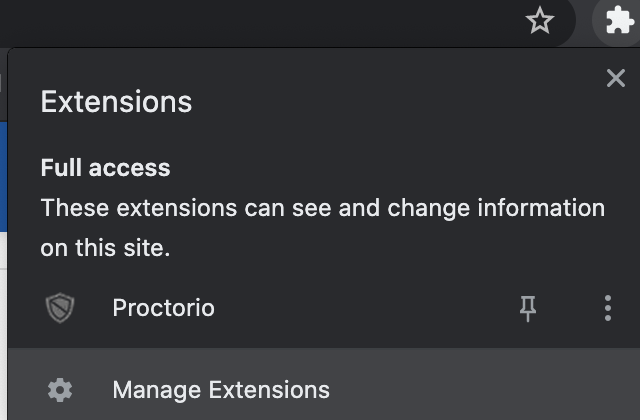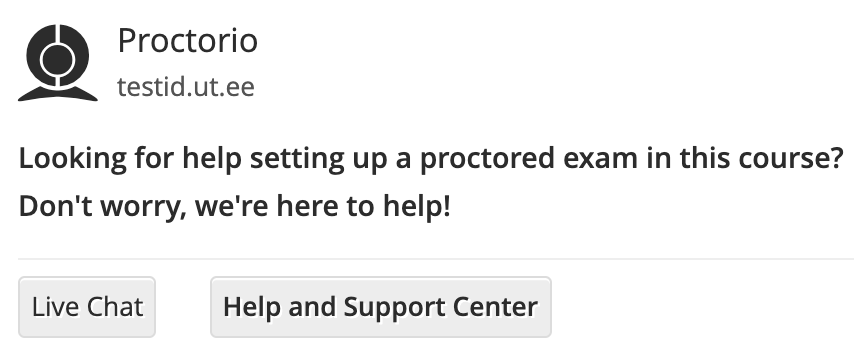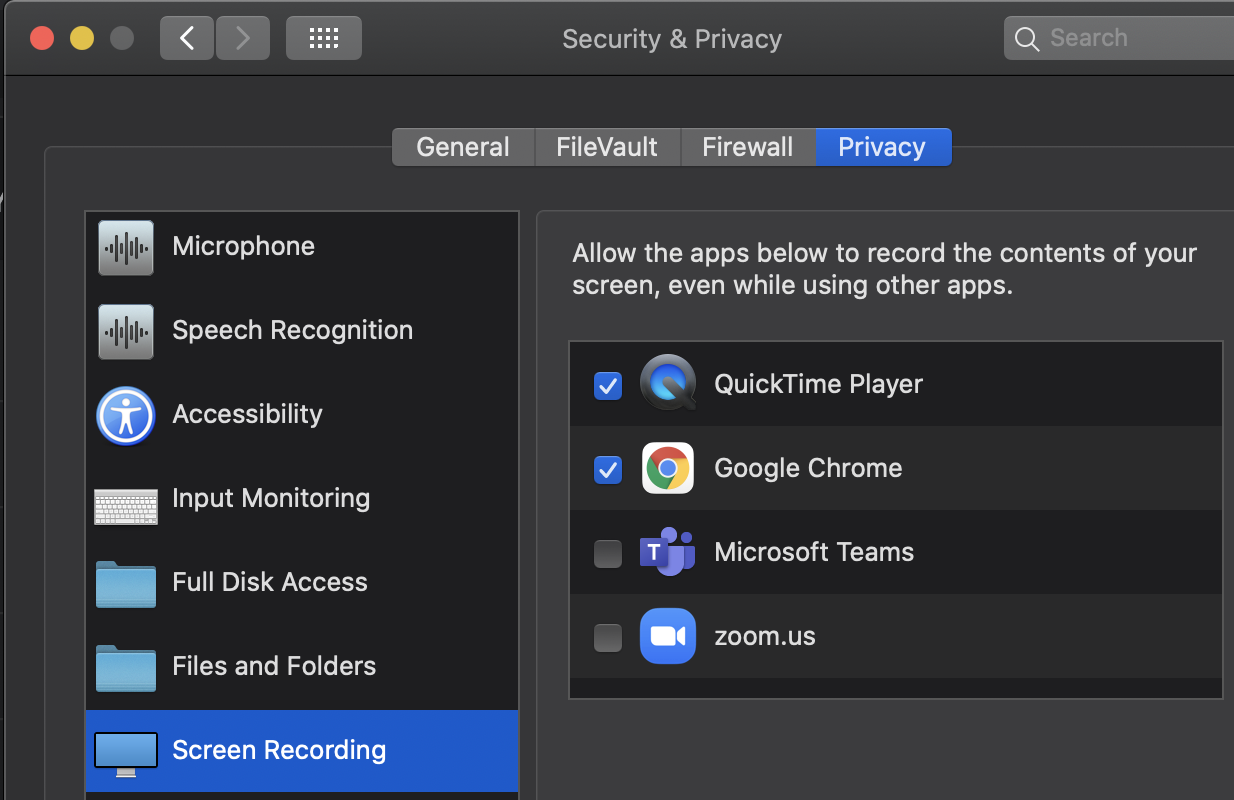- Home
- Moodle
- SIS2-Moodle integration
- SIS1-Moodle integration
- Basic features of Moodle
- Adding and creating study materials (resources)
- Communication in Moodle
- Tips for adapting assessment for distance learning
- Submitting homework in Moodle (activities)
- Creating a quiz in Moodle
- Group work in an e-course
- Grading learners in Moodle
- Teaching a course
- Taking attendance
- Transferring grades from Moodle to SIS exams results report
- Resetting a course in Moodle
- Moodle instructions for students
- Sisu@UT
- Panopto
- Mahara
- LimeSurvey
- Webinars
- Plagiarism detection

Guides for e-learning tools
Guidelines for taking a test with Proctorio
Summary
|
Proctorio (https://proctorio.com) is a monitoring system for electronic tests that helps to identify possible violations by test takers, i.e. academic fraud. During the test, the test taker is not monitored in real time, but a webcam, microphone and screen recorder are used to record a video of the test taker and what is happening on the computer screen.
It is recommended to use Microsoft Edge or Google Chrome to take a test with Proctorio. Install the Proctorio extension (Chrome, Edge) in the browser. Proctorio is also compatible with Opera and Brave (used with Proctorio Chrome extension). The extension needs to be installed once and is automatically updated. After taking a sample test or a real test with Proctorio, it is recommended to disable the Proctorio extension in the Extensions section of browser settings or to uninstall Proctorio if you know that you no longer need it.
Taking a test with Proctorio requires equipment and internet connection that meet certain specific requirements: https://proctorio.com/system-requirements
To take a test, the you must use the Proctorio extension to give access to your computer and allow the webcam image, microphone sound and computer screen to be recorded. Just before starting the test, you will need to confirm agreeing to the recording.
The data stored during the test attempt will move in encrypted form to the server of Proctorio’s service provider located in the European Union and will be automatically deleted after one month. A contract approved by the Estonian Data Protection Inspectorate has been concluded with the service provider and the collected data will be processed under the General Data Protection Regulation of the European Union (GDPR).
Entering the testing environment
Proctorio is available in the testing environment https://testid.ut.ee, which is a separate Moodle installation for admission and exam tests.
The testing environment can be accessed with the university’s computer network username and password (NOT OpenID like Moodle). If you have entered the testing environment with your user account and your personal identification code imported from the university’s central register is available in the database, you can later enter the environment with an ID card or Smart-ID. If you have added your mobile phone number to your profile (in the Optional section), you can also enter with Mobile-ID.
As the testing environment is not integrated with the SIS, the test takers will not be added to the necessary course in the testing environment via the SIS, but the lecturer will send all test takers a self-registration link with the key allowing self-registration.
1. Place of taking the test and prohibited materials
1.1. The test taker is free to choose the place of taking the test as long as the following conditions are met.
1.2. The room must have good lighting (daylight, general lighting). The light source must not be located directly behind the test taker.
1.3. The test taker must be alone in the room.
1.4. The test taker must be seated at a desk and all prohibited materials must be removed from all surrounding surfaces during the test.
1.5. As a general rule, the following materials are prohibited:
- books;
- paper;
- pencils;
- calculator;
- tablet;
- telephone (unless the test taker needs to report technical failures);
- headphones (including earbuds);
- additional computer or monitor.
1.6. The test taker’s ears must be visible (wearing a hat is not allowed and long hair must be tied back so that the possible use of headphones could be detected).
1.7. The test taker’s room must be as quiet as possible. Music, television and other sounds are not allowed.
1.8. When requested, the test taker must use the webcam to scan his or her surroundings at the start of and during the test.
1.9. If the test taker cannot find a room that meets the conditions, he or she must be given the opportunity to come to the university premises (with the personal or university’s computer).
2. Equipment and internet access
2.1. The test taker needs a laptop or computer that meets the hardware and software requirements, (internal or external) devices and internet connection.
2.2. The laptop or computer must meet the following requirements:
- a functional webcam (internal or external) capable of recording video;
- a functional microphone (internal or external) capable of recording sound;
- a functional computer keyboard and mouse (if necessary),
- available RAM of 2 GB (minimum storage capacity not used by other applications).
2.3. Other requirements are as follows:
- internet connection (minimum upload rate of 1 MB per second),
- Microsoft Edge or Google Chrome (version 10 or later);
- Proctorio browser extension (Chrome, Edge).
2.4. For more detailed requirements for devices and the internet connection, see https://proctorio.com/system-requirements.
2.5. The technical readiness of the laptop or computer and its accessories and internet connection can be tested by taking the sample test before the real test if the lecturer offers the sample test opportunity.
2.6. For technical support when installing the Proctorio extension and in case of technical problems, contact the UT IT helpdesk at arvutiabi@ut.ee and phone 7375500. While taking the test, you can also ask for help (in English) 24/7 in the Proctorio Live Chat. Click on the Extensions icon in the web browser and then on “Proctorio”. The live chat window will open.

|

|
2.7. If the test taker does not have suitable equipment or the sample test reveals that the test taker’s equipment or internet connection does not meet the requirements, it must be possible to come to the university’s premises to take the test (using the university’s computer).
3. Permitted and prohibited activities during the test
3.1. The test taker is allowed to drink during the test.
3.2. Before starting the test, the test taker must
- close all programs on the laptop or computer apart from the web browser used for taking the test;
- close redundant browser tabs;
- unplug additional monitors from the laptop or computer;
- restart the laptop or computer if its RAM capacity is insufficient.
3.3. During the test, the test taker must not
- communicate with other persons in any way (except to report technical failures);
- use prohibited materials listed in the test introduction;
- turn off screen sharing (ends the test automatically);
- turn off the full-screen mode, i.e. by opening other websites or other programs, including by using key combinations (the system detects the end of full-screen mode and gives a warning; if the user does not return to full-screen mode within the given time, the test attempt is automatically terminated);
- disable or mute the microphone (ends the test automatically);
- disable or cover the webcam (ends the test automatically).
3.4. In general, the test taker is not allowed to leave the seat or the room (inactivity for more than two minutes automatically ends the test). If test takers are allowed to leave the room for a break during longer tests, the lecturers have announced this in advance.
3.5. Prohibited activities are recorded and some of them automatically end the test attempt. If the test configuration allows the test taker to return to the test, the test taker can continue the test, but the recording of the test will include a record of the interruption and the previous activity. After the test, the test taker can leave a comment in the designated field to explain interruptions or activities that might have been classified as violations by the system.
4. Sample test
4.1. Everyone who is registered for a test to be supervised by Proctorio must be given the opportunity to take a sample test before the official test to know how the testing will be conducted and whether the equipment and the internet connection function properly.
4.2. If a person registered for a test to be supervised by Proctorio tries taking the sample test and feels that he or she does not wish to take the test in this way for technical or other reasons, he or she must inform the lecturer, so that the lecturer could offer the person an alternative option for taking the test on the university’s premises with personal or university’s computer.
5. Starting the test
5.1. To take the test, log in to https://testid.ut.ee, enter the course of the test and give consent to the recording.
5.2. After that, compliance with the technical requirements will be checked. If you are a Mac user and have problems with sharing the screen, allow screen recording in Chrome (System preferences > Security&Privacy > Privacy > tick “Google Chrome” in Screen Recording settings).

5.3. At the request of the test organiser, you have to pass the identity verification by taking a picture of yourself and your ID document using the webcam.
5.4. At the request of the test organiser, you have to use the webcam to scan the room in which you will take the test.
5.5. Before the test can start, you will have to agree to the terms and conditions of the supervision system (Exam agreement).
5.6. The instructions given by the system will be in English.
6. End of test
6.1. As a rule, after completing the test, the test taker can use the designated comment field to explain whether anything happened during the test that could be classified as a prohibited activity.
6.2. It is advisable to remove the Proctorio extension from the laptop or computer after completing the test.
7. Issues encountered during the test and support for overcoming them
7.1. Before and during the test, the lecturers will help the test takers with organisational questions and the IT helpdesk in case of technical problems.
7.2. If you encounter a problem during the test that terminates the test attempt and you cannot return to the test (e.g. a power failure, loss of internet connection, failure in the testing environment and/or Proctorio) and it is not possible to complete the test, inform the lecturer who organises the test.
8. Review of recordings and announcement of test results
8.1. Within the agreed time after completing the test, the lecturer/examiner analyses the recordings to determine whether the test taker has completed the test without undue assistance.
8.2. The grades will be announced after all recordings have been analysed.
8.3. If the analysis of recordings reveals the use of prohibited aid (academic fraud), the cases will be processed as usual cases of academic fraud.
8.4. Recordings are kept on the service provider’s server for one month and then automatically deleted.
9. Processing of personal data
9.1. The University of Tartu has an obligation under the General Data Protection Regulation to ensure that the personal data of the test takers is processed according to data protection requirements. The University of Tartu processes the following personal data of test takers:
- name and surname;
- email address;
- at the request of the test organiser, an image of the test taker’s ID card;
- image of the test taker’s face;
- video and audio recording of the room in which the test is taken;
- recording of the on-screen activities during the test;
- keystrokes, cursor movement and webpage visits during the test;
- the IP address of the computer network your laptop or computer is connected to;
- log entries for all activities during the test;
- answers to test questions and test results.
9.2. Personal data will be used only to
- identify the person who took the test;
- detect fraudulent practices to check whether the rules in force have been complied with;
- verify the use of time to check whether the test was completed within the prescribed time.


